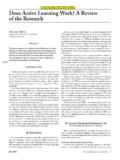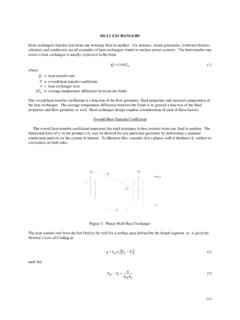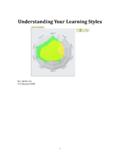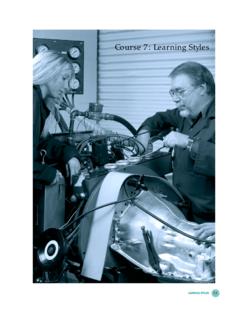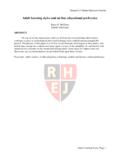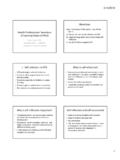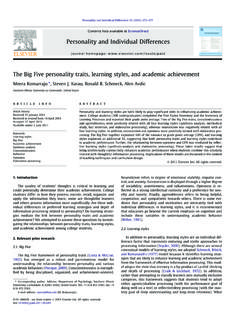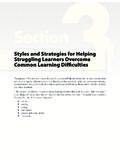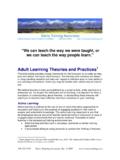Transcription of LEARNING STYLES AND STRATEGIES1 Richard M. Felder …
1 LEARNING STYLES AND STRATEGIES1 Richard M. Felder Hoechst Celanese Professor of Chemical Engineering North Carolina State University Barbara A. Soloman Coordinator of Advising, First Year College North Carolina State University ACTIVE AND REFLECTIVE LEARNERS2 Active learners tend to retain and understand information best by doing something active with it discussing or applying it or explaining it to others. Reflective learners prefer to think about it quietly first. Let s try it out and see how it works is an active learner s phrase; Let s think it through first is the reflective learner s response. Active learners tend to like group work more than reflective learners, who prefer working alone.
2 Sitting through lectures without getting to do anything physical but take notes is hard for both LEARNING types, but particularly hard for active learners. Everybody is active sometimes and reflective sometimes. Your preference for one category or the other may be strong, moderate, or mild. A balance of the two is desirable. If you always act before reflecting you can jump into things prematurely and get into trouble, while if you spend too much time reflecting you may never get anything done. How can active learners help themselves? If you are an active learner in a class that allows little or no class time for discussion or problem-solving activities, you should try to compensate for these lacks when you study.
3 Study in a group in which the members take turns explaining different topics to each other. Work with others to guess what you will be asked on the next test and figure out how you will answer. You will always retain information better if you find ways to do something with it. How can reflective learners help themselves? If you are a reflective learner in a class that allows little or not class time for thinking about new information, you should try to compensate for this lack when you study. Don t simply read or memorize the material; stop periodically to review what you have read and to think of possible questions or applications.
4 You might find it helpful to write short summaries of readings or class notes in your own words. Doing so may take extra time but will enable you to retain the material more effectively. 1 1993 by Richard M. Felder and Barbara A. Soloman. See < > for additional details about the Index of LEARNING STYLES and the Felder -Silverman LEARNING STYLES model upon which the ILS is based. 2 Felder and R. Brent, Teaching and LEARNING STEM: A Practical Guide, San Francisco: Jossey-Bass (2016), pp. 107 109. < >. 2 SENSING AND INTUITIVE LEARNERS3 Sensing learners tend to like LEARNING facts, intuitive learners often prefer discovering possibilities and relationships.
5 Sensors often like solving problems by well-established methods and dislike complications and surprises; intuitors like innovation and dislike repetition. Sensors are more likely than intuitors to resent being tested on material that has not been explicitly covered in class. Sensors tend to be patient with details and good at memorizing facts and doing hands-on (laboratory) work; intuitors may be better at grasping new concepts and are often more comfortable than sensors with abstractions and mathematical formulations. Sensors tend to be more practical and careful than intuitors; intuitors tend to work faster and to be more innovative than sensors.
6 Sensors don t like courses that have no apparent connection to the real world; intuitors don t like plug-and-chug courses that involve a lot of memorization and routine calculations. Everybody is sensing sometimes and intuitive sometimes. Your preference for one or the other may be strong, moderate, or mild. To be effective as a learner and problem solver, you need to be able to function both ways. If you overemphasize intuition, you may miss important details or make careless mistakes in calculations or hands-on work; if you overemphasize sensing, you may rely too much on memorization and familiar methods and not concentrate enough on understanding and innovative thinking.
7 How can sensing learners help themselves? Sensors remember and understand information best if they can see how it connects to the real world. If you are in a class where most of the material is abstract and theoretical, you may have difficulty. Ask your instructor for specific examples of concepts and procedures, and find out how the concepts apply in practice. If the teacher does not provide enough specifics, try to find some in your course text or other references or by brainstorming with friends or classmates. How can intuitive learners help themselves? Many college lecture classes are aimed at intuitors. However, if you are an intuitor and you happen to be in a class that deals primarily with memorization and rote substitution in formulas, you may have trouble with boredom.
8 Ask your instructor for interpretations or theories that link the facts, or try to find the connections yourself. You may also be prone to careless mistakes on test because you are impatient with details and don t like repetition (as in checking your completed solutions). Take time to read the entire question before you start answering and be sure to check your results. VISUAL AND VERBAL LEARNERS1 Visual learners remember best what they see pictures, diagrams, flow charts, time lines, films, and demonstrations. Verbal learners get more out of words written and spoken explanations. Everyone learns more when information is presented both visually and verbally.
9 3 Felder and R. Brent, Teaching and LEARNING STEM: A Practical Guide, San Francisco: Jossey-Bass (2016), pp. 187 188. < >. 3In most college classes very little visual information is presented: students mainly listen to lectures and read material written on chalkboards and in textbooks and handouts. Unfortunately, most people are visual learners, which means that most students do not get nearly as much as they would if more visual presentation were used in class. Good learners are capable of processing information presented either visually or verbally. How can visual learners help themselves?
10 If you are a visual learner, try to find diagrams, sketches, schematics, photographs, flow charts, or any other visual representation of course material that is predominantly verbal. Ask your instructor, consult reference books, and see if any videotapes or CD-ROM displays of the course material are available. Prepare a concept map by listing key points, enclosing them in boxes or circles, and drawing lines with arrows between concepts to show connections. Color-code your notes with a highlighter so that everything relating to one topic is the same color. How can verbal learners help themselves? Write summaries or outlines of course material in your own words.
